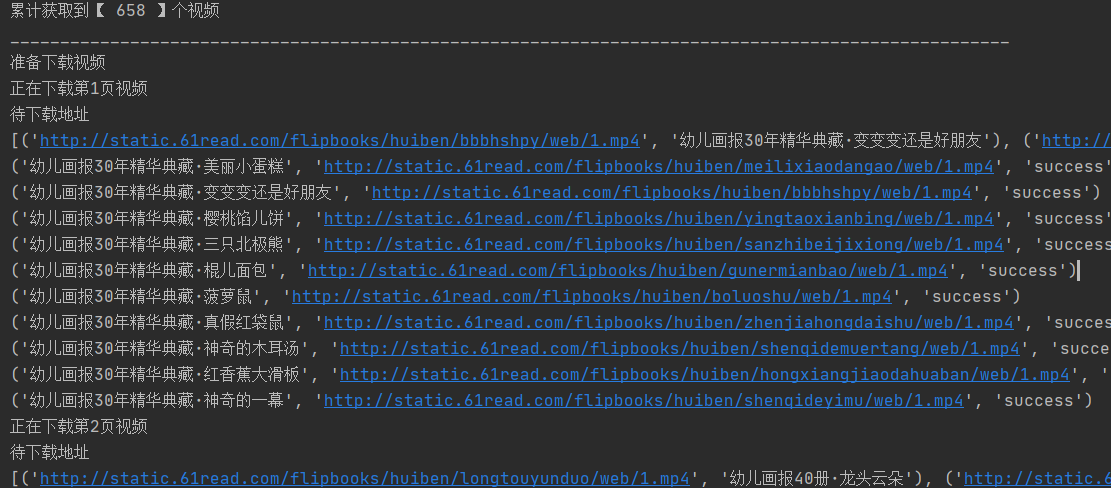在 python 爬虫中使用协程,能大幅度提高对目标站点的采集效率,所以我们要反复学习本概念,并将其用在爬虫案例中。
协程的定义
有了两篇文章的铺垫,现在定义一个协程应该是非常简单的了,在一个函数前面增加 async 关键字,函数就变成了协程,你可以直接通过 isinstance 函数,验证其类型。
from collections.abc import Coroutine
async def func(): print("我是协程函数")
if __name__ == '__main__': # 创建协程对象,注意协程对象不会运行函数内代码,即不会输出任何信息 coroutine = func()
# 类型判断 print(isinstance(coroutine, Coroutine))
复制代码
代码输入如下内容:
Truesys:1: RuntimeWarning: coroutine 'func' was never awaited
复制代码
通过类型判断,得到添加 async 关键字的函数是协程类型,下面的警告暂时忽略,原始是该协程没有被注册到事件循环中并得到调用。
使用协程
本次依旧采用一个爬虫案例学习协程,目标站点为 http://banan.huiben.61read.com/,该站点为中少绘本网站,它是中国少年儿童新闻出版总社旗下的绘本网站,网站有大量儿童绘本动画,并且无广告,动画都是 MP4 格式,便于下载。
import asyncio
import requests
# 协程函数async def get_html(): res = requests.get("http://banan.huiben.61read.com/Video/List/1d4a3be3-0a72-4260-979b-743d9db8ad85") if res is not None: return res.status_code else: return None
# 声明协程对象coroutine = get_html()
# 事件循环对象loop = asyncio.get_event_loop()
# 将协程转换为任务task = loop.create_task(coroutine)# task = asyncio.ensure_future(coroutine) # 使用该方法,也可以将协程转换为任务
# 将 task 任务放入事件循环中并调用loop.run_until_complete(task)
# 输出结果print("结果输出",task.result())
复制代码
也可以对上述代码进行改造,python3.7 之后,可以使用 asyncio.run() 方法来运行最高层级的入口函数。
import asyncioimport requests
# 协程函数async def get_html(): res = requests.get("http://banan.huiben.61read.com/Video/List/1d4a3be3-0a72-4260-979b-743d9db8ad85") if res is not None: print(res.status_code) else: return None
async def main(): await get_html()
# 声明协程对象coroutine = get_html()
asyncio.run(main())
复制代码
接下来参考上述代码,实现对两个 MP4 视频的下载。
# http://static.61read.com/flipbooks/huiben/huazhuangwuhui/web/1.mp4# http://static.61read.com/flipbooks/huiben/jingubanghexiaofengche/web/1.mp4import asyncioimport timeimport requests
async def requests_get(url): headers = { "Referer": "http://banan.huiben.61read.com/", "User-Agent": "Mozilla/5.0 (Windows NT 6.1; Win64; x64) AppleWebKit/537.36 (KHTML, like Gecko) Chrome/94.0.4606.54 Safari/537.36" } try: res = requests.get(url, headers=headers) return res except Exception as e: print(e) return None
async def get_video(url): res = await requests_get(url) if res is not None: with open(f'./mp4/{time.time()}.mp4', "wb") as f: f.write(res.content)
async def main(): start_time = time.perf_counter() # http://static.61read.com/flipbooks/huiben/huazhuangwuhui/web/1.mp4 # http://static.61read.com/flipbooks/huiben/jingubanghexiaofengche/web/1.mp4
await get_video("http://static.61read.com/flipbooks/huiben/huazhuangwuhui/web/1.mp4") await get_video("http://static.61read.com/flipbooks/huiben/jingubanghexiaofengche/web/1.mp4")
print("代码运行时间:", time.perf_counter() - start_time)
if __name__ == '__main__': asyncio.run(main())
复制代码
测试在上述代码下,下载两个视频耗时 44S(不同电脑与网速时间不同)。
使用 asyncio.create_task() 函数用来并发运行多个协程继续修改代码,优化执行时间。
import asyncioimport timeimport requests
async def requests_get(url): headers = { "Referer": "http://banan.huiben.61read.com/", "User-Agent": "Mozilla/5.0 (Windows NT 6.1; Win64; x64) AppleWebKit/537.36 (KHTML, like Gecko) Chrome/94.0.4606.54 Safari/537.36" } try: res = requests.get(url, headers=headers) return res except Exception as e: print(e) return None
async def get_video(url): res = await requests_get(url) if res is not None: with open(f'./mp4/{time.time()}.mp4', "wb") as f: f.write(res.content)
async def main(): start_time = time.perf_counter() # http://static.61read.com/flipbooks/huiben/huazhuangwuhui/web/1.mp4 # http://static.61read.com/flipbooks/huiben/jingubanghexiaofengche/web/1.mp4
task1 = asyncio.create_task( get_video("http://static.61read.com/flipbooks/huiben/huazhuangwuhui/web/1.mp4"))
task2 = asyncio.create_task( get_video("http://static.61read.com/flipbooks/huiben/jingubanghexiaofengche/web/1.mp4")) await task1 await task2 print("代码运行时间:", time.perf_counter() - start_time)
if __name__ == '__main__': asyncio.run(main())
复制代码
代码运行时间为 27S,可以看到效率得到了提升。在正式分析上述代码前,先学习一个 可等待对象 概念
可等待对象可以在 await 语句中使用的对象,就是可等待对象,可等待对象有三种主要类型:协程,任务,Future
协程在 python 中一定要区分好,协程函数与协程对象,后者是前者所返回的对象。
创建任务asyncio.create_task(coro, *, name=None) 为创建任务对象并调度其执行,参数 1 为协程对象,参数 2 为任务名称,该函数是 python3.7 之后加入的,如果使用之前的版本,请使用 asyncio.ensure_future() 函数。
并发运行任务函数原型如下所示:
asyncio.gather(*aws, loop=None, return_exceptions=False) -> awaitable
复制代码
并发运行序列中的可等待对象,如果 aws 中的某个可等待对象为协程,它将自动被作为一个任务调度。
return_exceptions 参数说明:
return_exceptions 为 False (默认),所引发的首个异常会立即传播给等待 gather() 的任务。aws 序列中的其他可等待对象不会被取消并将继续运行;
return_exceptions 为 True,异常会和成功的结果一样处理,并聚合至结果列表。
如果 gather() 被取消,所有被提交 (尚未完成) 的可等待对象也会被取消。
简单等待函数原型如下:
asyncio.wait(aws, *, loop=None, timeout=None, return_when=ALL_COMPLETED) -> coroutine
复制代码
并发运行 aws 指定的可等待对象并阻塞线程直到满足 return_when 指定的条件。
如果 aws(上述参数) 中的某个可等待对象为协程,它将自动作为任务加入日程。直接向 wait() 传入协程对象已弃用。
该函数返回两个 Task/Future 集合,一般写作 (done, pending)。
return_when 指定此函数应在何时返回。它必须为以下常数之一:
FIRST_COMPLETED:函数将在任意可等待对象结束或取消时返回;
FIRST_EXCEPTION:函数将在任意可等待对象因引发异常而结束时返回。当没有引发任何异常时它就相当于 ALL_COMPLETED;
ALL_COMPLETED:函数将在所有可等待对象结束或取消时返回。
与 wait() 方法类似的一个方法是 wait_for,该方法原型如下:
asyncio.wait_for(aw, timeout, *, loop=None) -> coroutine
复制代码
等待 aw 可等待对象 完成,指定 timeout 秒数后超时。
这个函数可以传递协程,如果发生超时,任务取消并引发 asyncio.TimeoutError。
wait() 与 wait_for() 的区别是:wait() 在超时发生时不会取消可等待对象。
绑定回调函数
异步 I/O 的实现原理,就是在 I/O 操作的地方挂起程序,等 I/O 结束后,再继续执行。编写爬虫程序,很多时候都要依赖 IO 的返回值,这就要用到回调了。同步编程实现回调
直接在 await 前声明变量,获取回调值
import asyncioimport timeimport requests
async def requests_get(url): headers = { "Referer": "http://banan.huiben.61read.com/", "User-Agent": "Mozilla/5.0 (Windows NT 6.1; Win64; x64) AppleWebKit/537.36 (KHTML, like Gecko) Chrome/94.0.4606.54 Safari/537.36" } try: res = requests.get(url, headers=headers) return res except Exception as e: print(e) return None
async def get_video(url): res = await requests_get(url) if res is not None: with open(f'./mp4/{time.time()}.mp4', "wb") as f: f.write(res.content) return (url,"success") else: return None
async def main(): start_time = time.perf_counter() # http://static.61read.com/flipbooks/huiben/huazhuangwuhui/web/1.mp4 # http://static.61read.com/flipbooks/huiben/jingubanghexiaofengche/web/1.mp4
task1 = asyncio.create_task( get_video("http://static.61read.com/flipbooks/huiben/huazhuangwuhui/web/1.mp4"))
task2 = asyncio.create_task( get_video("http://static.61read.com/flipbooks/huiben/jingubanghexiaofengche/web/1.mp4")) # 同步回调方法 ret1 = await task1 ret2 = await task2 print(ret1,ret2) print("代码运行时间:", time.perf_counter() - start_time)
if __name__ == '__main__': asyncio.run(main())
复制代码
通过 asyncio 添加回调函数功能来实现
用到的方式是 add_done_callback,添加一个回调,该回调将在 Task 对象完成时被运行。与之对应的是移除回调函数,remove_done_callback。
import asyncioimport timeimport requests
async def requests_get(url): headers = { "Referer": "http://banan.huiben.61read.com/", "User-Agent": "Mozilla/5.0 (Windows NT 6.1; Win64; x64) AppleWebKit/537.36 (KHTML, like Gecko) Chrome/94.0.4606.54 Safari/537.36" } try: res = requests.get(url, headers=headers) return res except Exception as e: print(e) return None
async def get_video(url): res = await requests_get(url) if res is not None: with open(f'./mp4/{time.time()}.mp4', "wb") as f: f.write(res.content) return (url, "success") else: return None
async def main(): start_time = time.perf_counter() # http://static.61read.com/flipbooks/huiben/huazhuangwuhui/web/1.mp4 # http://static.61read.com/flipbooks/huiben/jingubanghexiaofengche/web/1.mp4
task1 = asyncio.create_task( get_video("http://static.61read.com/flipbooks/huiben/huazhuangwuhui/web/1.mp4")) task1.add_done_callback(callback)
task2 = asyncio.create_task( get_video("http://static.61read.com/flipbooks/huiben/jingubanghexiaofengche/web/1.mp4")) task2.add_done_callback(callback) # 同步回调方法 await task1 await task2 print("代码运行时间:", time.perf_counter() - start_time)
def callback(future): print('回调函数,返回结果是:', future.result())
if __name__ == '__main__': asyncio.run(main())
复制代码
本节课的爬虫案例
本节课爬虫由于涉及很多 MP4 视频,完整代码在 codechina 下载,主要思路整理如下。
第一步:获取所有列表页的地址具体数据位置如下所示,由于数据都在一个页面中,顾获取方式比较简单,直接解析网页即可。
第二步:获取视频下载地址通过下述流程获取视频地址,在查找过程中发现,视频缩略图的地址与视频播放器地址存在一定的规律,如下所示:
# 视频缩略图地址http://static.61read.com/flipbooks/huiben/chudiandetouyuzei/cover.jpg# 视频地址http://static.61read.com/flipbooks/huiben/chudiandetouyuzei/web/1.mp4
复制代码
即去除 cover.jpg,替换为 web/1.mp4,这样大幅度降低我们获取视频的层级了。
第三步:编写代码下载视频
import asyncioimport timeimport requestsfrom bs4 import BeautifulSoupimport lxml
BASE_URL = "http://banan.huiben.61read.com"
async def requests_get(url): headers = { "Referer": "http://banan.huiben.61read.com/", "User-Agent": "Mozilla/5.0 (Windows NT 6.1; Win64; x64) AppleWebKit/537.36 (KHTML, like Gecko) Chrome/94.0.4606.54 Safari/537.36" } try: res = requests.get(url, headers=headers) return res except Exception as e: print(e) return None
async def get_video(name, url): res = await requests_get(url) if res is not None: with open(f'./mp4/{name}.mp4', "wb") as f: f.write(res.content) return (name, url, "success") else: return None
async def get_list_url(): """获取列表页地址""" res = await requests_get("http://banan.huiben.61read.com/") soup = BeautifulSoup(res.text, "lxml") all_a = [] for ul in soup.find_all(attrs={'class', 'inline'}): all_a.extend(BASE_URL + _['href'] for _ in ul.find_all('a')) return all_a
async def get_mp4_url(url): """获取MP4地址""" res = await requests_get(url) soup = BeautifulSoup(res.text, "lxml") mp4s = [] for div_tag in soup.find_all(attrs={'class', 'item_list'}): # 获取图片缩略图 src = div_tag.a.img['src'] # 将缩略图地址替换为 mp4 视频地址 src = src.replace('cover.jpg', 'web/1.mp4').replace('cover.png', 'web/1.mp4') name = div_tag.div.a.text.strip() mp4s.append((src, name))
return mp4s
async def main(): # 获取列表页地址任务 task_list_url = asyncio.create_task(get_list_url()) all_a = await task_list_url # 创建任务列表 tasks = [asyncio.ensure_future(get_mp4_url(url)) for url in all_a] # 添加回调函数 # ret = map(lambda x: x.add_done_callback(callback), tasks) # 异步执行 dones, pendings = await asyncio.wait(tasks) all_mp4 = [] for task in dones: all_mp4.extend(task.result()) # 获取到所有的MP4地址
totle = len(all_mp4) print("累计获取到【", totle, "】个视频") print("_" * 100) print("准备下载视频")
# 每次下载10个 totle_page = totle // 10 if totle % 10 == 0 else totle // 10 + 1 # print(totle_page) for page in range(0, totle_page): print("正在下载第{}页视频".format(page + 1)) start_page = 0 if page == 0 else page * 10 end_page = (page + 1) * 10 print("待下载地址") print(all_mp4[start_page:end_page]) mp4_download_tasks = [asyncio.ensure_future(get_video(name, url)) for url, name in all_mp4[start_page:end_page]] mp4_dones, mp4_pendings = await asyncio.wait(mp4_download_tasks) for task in mp4_dones: print(task.result())
if __name__ == '__main__': asyncio.run(main())
复制代码
写在后面
如需完整代码,请查看评论区置顶评论。
今天是持续写作的第 <font color=red>243</font> / 365 天。期待 <font color=#04a9f4>关注</font>,<font color=#04a9f4>点赞</font>、<font color=#04a9f4>评论</font>、<font color=#04a9f4>收藏</font>。















评论